While there are 240 woodpecker species across the globe, only 22 inhabit the United States. And of those 22, seven woodpecker species live within Indiana’s borders. There is no doubt that woodpeckers are especially unique birds that have unusual adaptations to help them thrive in their environments, including zygodactyl toes and protective tongues that wrap around their brains. Check out the seven woodpeckers in Indiana and learn how to identify them and their locations.
1. Downy Woodpecker
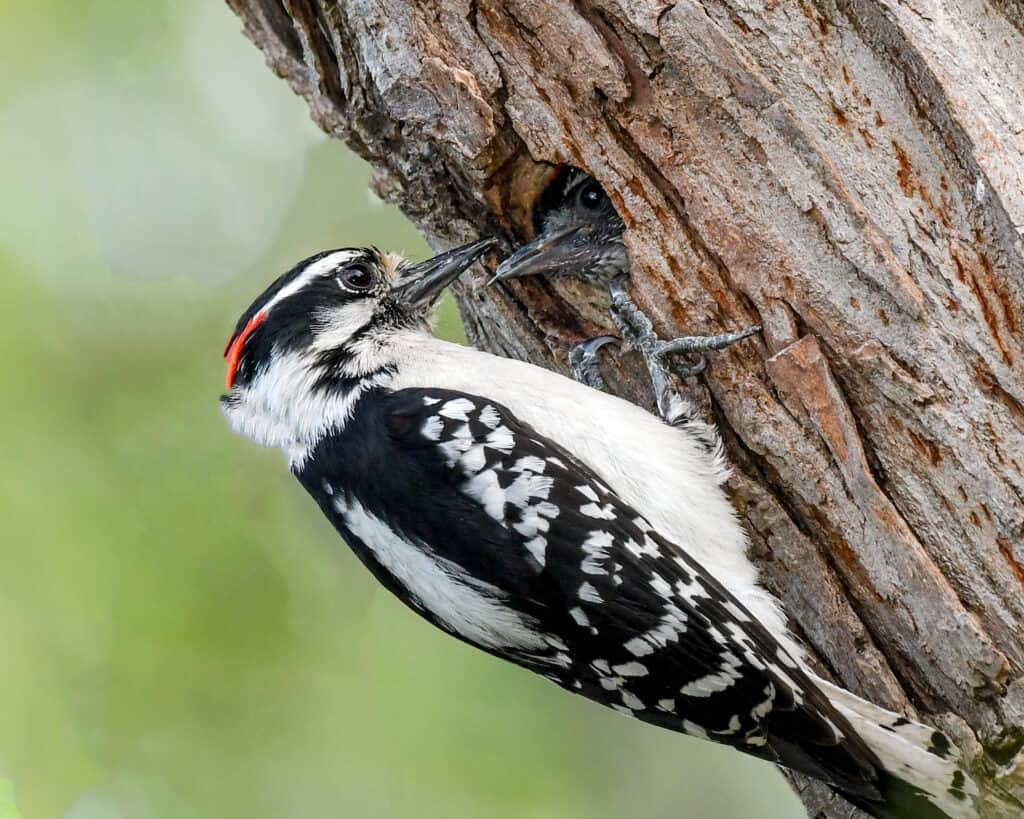
Downy woodpeckers are common woodpeckers in Indiana.
©Brent Barnes/Shutterstock.com
The downy woodpecker is the smallest woodpecker species in North America. They are between five and six inches long and only weigh around one ounce. These woodpeckers have straight backs that lean away from the tree, straight bills, broad shoulders, and boxy heads. Their plumage is checkered black and white on the body, and the head is striped, with a broad white stripe going down the center of the back. Males also feature red patches toward the backs of their heads.
Downy woodpeckers live in open woodlands near streams. But you can also commonly find them in parks, backyards, and orchards. This species is the most common woodpecker in Indiana, where you can find them in many habitats, especially deciduous woods near water.
2. Red-Bellied Woodpecker
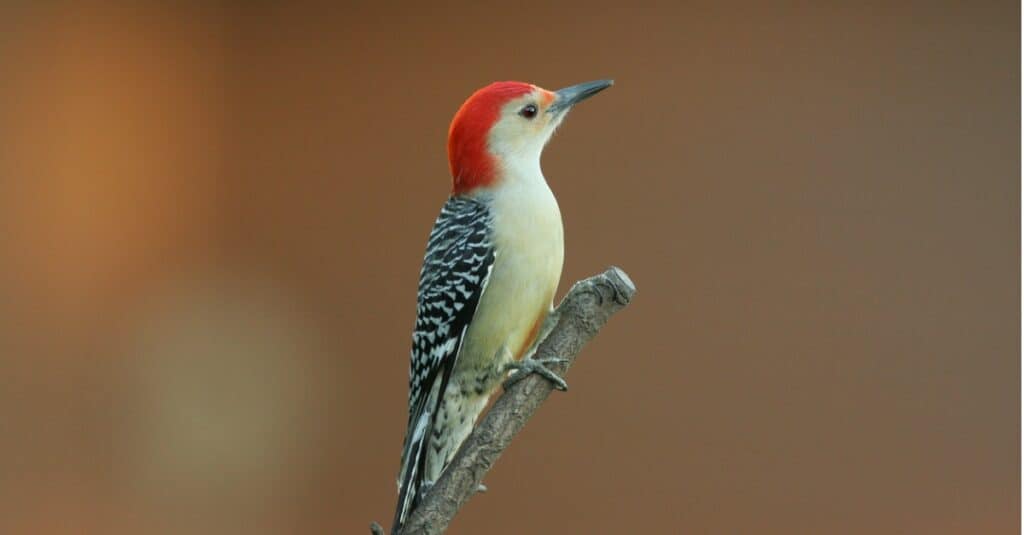
As confusing as the red head may be, the red-bellied woodpecker does, in fact, have a red belly.
©iStock.com/Flatcoater
These medium-sized woodpeckers are around the same size as hairy woodpeckers but with different outlines. Red-bellied woodpeckers are sleek birds with round heads and bold black-and-white patterns. Their faces and chests are buff-colored, and bright reddish-orange broad stripes run from their foreheads to the backs of their necks, except for females who lack the red crown.
This species prefers to pick at tree bark rather than drill into it. And you can find them in woodlands, forests, wooded suburbs, and backyards with bird feeders. Red-bellied woodpeckers are common throughout Indiana all year, where they like to frequent suet feeders. These birds are much bigger than downy woodpeckers, measuring over nine inches and weighing two to three ounces.
3. Hairy Woodpecker
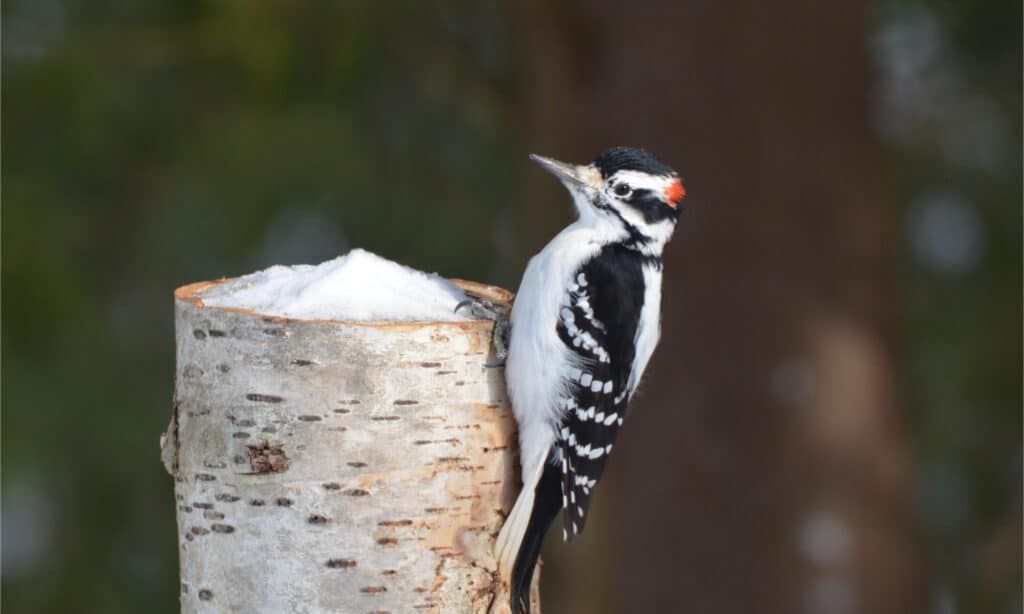
Hairy woodpeckers are slightly smaller than downy woodpeckers.
©C. Hamilton/Shutterstock.com
The hairy woodpecker is a medium-sized species found widespread across North America. This species measures between seven and ten inches long and weighs approximately one to three ounces. Their square heads and long bills are defining features of this woodpecker. Like many North American woodpeckers, the hairy woodpecker features black and white patterns on the body. And its head has two white stripes with red crowns in males.
These birds prefer mature forests, where they feed at the base of trees. But you can also spot them in woodlots, parks, suburbs, and even cemeteries. They are year-round residents in Indiana and across most of the United States. And you can often find them at residential bird feeders.
4. Red-Headed Woodpecker

Red-headed woodpeckers are easy to identify.
©Danita Delimont/Shutterstock.com
The red-headed woodpecker is very easy to identify. These medium-sized woodpeckers measure between seven to nine inches long and weigh between two and three ounces. They have bright red and fairly large, round heads. Their tails are also short and stiff, and their bills are long and sturdy. These birds feature white underparts, black backs, and broad white stripes on their wings.
Red-headed woodpeckers live in open forests, like pine savannas, where they feed on insects. You can find them hammering away at trees, hunting on the ground, or swooping for prey mid-air. In Indiana, you can spot them year-round near forest edges, tree groves, and farmland.
5. Pileated Woodpecker
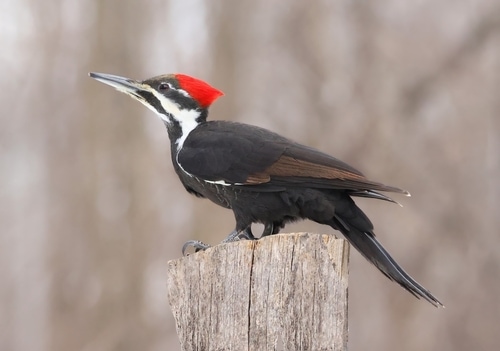
Pileated woodpeckers are very large.
©Vlad G/Shutterstock.com
The pileated woodpecker is another easy-to-identify species due to its large size and defining features. This species measures between 15 and 19 inches long and weighs eight to 12 ounces, with a nearly 30-inch wingspan. Pileated woodpeckers have long necks, long bills, and broad wings. And their bright red triangular crests help them stand out. These birds are almost entirely black, except for the white face and neck stripes, and white underwings.
Even their holes are distinctive, featuring a rectangular shape in rotten wood. These birds live in mature woodlands and suburban areas. This woodpecker is fairly common across Indiana woodlands.
6. Northern Flicker
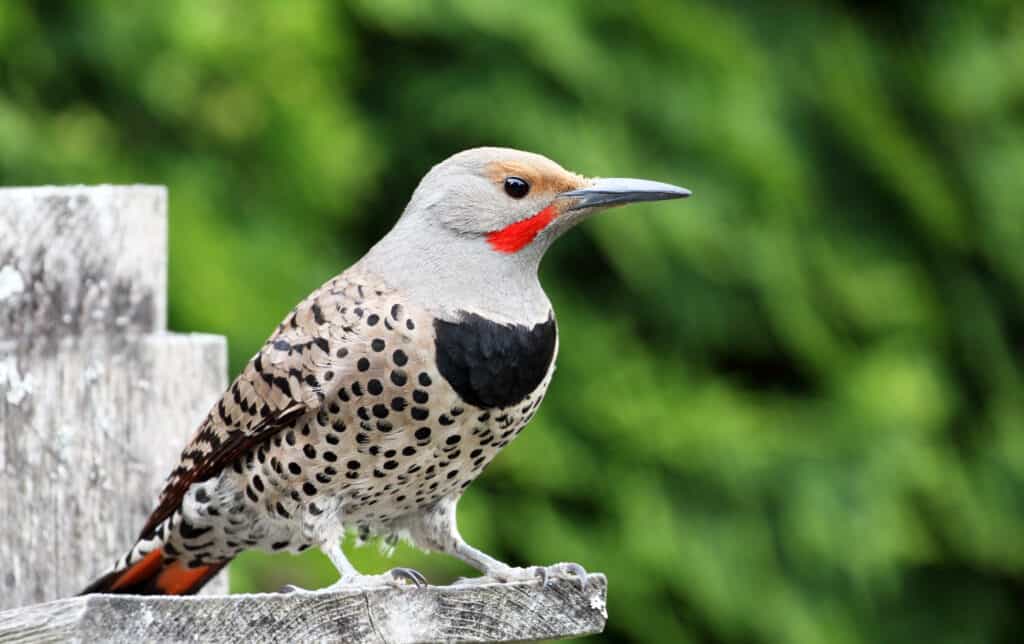
Northern flickers have unmistakable features.
©Birdiegal/Shutterstock.com
The northern flicker is another large woodpecker species, measuring 11 to 12 inches long and weighing between four and five ounces. They have slim, round heads, long tails, and thick downcurved bills. Northern flickers are unmistakable with their gray, buff, brown, black, and red plumage. They also have distinctive black spots on their bellies.
You can find them perched on horizontal branches in open habitats like forest edges, woodlands, parks, and backyards. These birds are common in Indiana year-round.
7. Yellow-Bellied Sapsucker

Yellow-belly sapsuckers are omnivores, and like their namesake, sapsuckers eat, live and breathe sap.
©Glass and Nature/Shutterstock.com
These medium-sized woodpeckers measure between seven and nine inches long and weigh one to two ounces. They have straight, broad bills and long wings. And they feature a bold black-and-white pattern, white face stripes, and bright red foreheads. Males also have red throats. To identify this species, look for their black chests, long white wing stripes, and white or yellowish underparts.
Yellow-bellied sapsuckers feed at sap wells in hardwood and conifer forests. You may occasionally find them at bird feeders. These birds spend winters in Southern Indiana and migrate through the northern portion of the state.
A Recap of the 7 Woodpeckers in Indiana
| Number | Woodpeckers in Indiana |
|---|---|
| #1 | Downy woodpecker |
| #2 | Red-bellied woodpecker |
| #3 | Hairy woodpecker |
| #4 | Red-headed woodpecker |
| #5 | Pileated woodpecker |
| #6 | Northern flicker |
| #7 | Yellow-bellied sapsucker |
The photo featured at the top of this post is © J Edwards Photography/Shutterstock.com
Thank you for reading! Have some feedback for us? Contact the AZ Animals editorial team.







